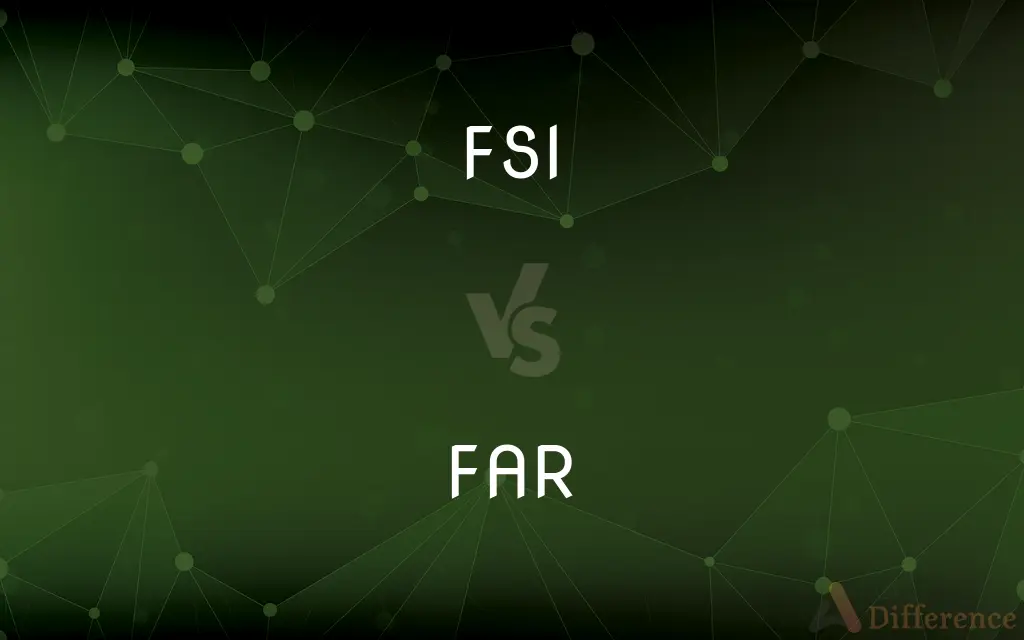FSI vs. FAR — What's the Difference?
By Tayyaba Rehman & Urooj Arif — Published on February 6, 2024
FSI (Floor Space Index) and FAR (Floor Area Ratio) are terms used in urban planning to dictate building size, but they are essentially the same concept expressed with different terminology.

Difference Between FSI and FAR
Table of Contents
ADVERTISEMENT
Key Differences
Both FSI and FAR are key urban planning metrics used to control the intensity of land use by dictating the total built-up area allowed on a plot. While FSI is commonly used in some countries like India, FAR is the preferred term in the United States and other regions, but both serve the same regulatory function in building and urban planning.
The calculation for both FSI and FAR involves dividing the total built-up area of a building by the total area of the plot. Despite this similarity, the terminology and specific regulatory standards may vary based on local laws and urban planning norms, with FSI often expressed as a percentage, while FAR is typically represented as a ratio.
FSI and FAR are crucial in shaping urban landscapes, dictating the extent to which land can be developed vertically. Higher FSI or FAR values allow for denser, taller buildings, while lower values ensure more open space and less densely packed structures. Both terms are instrumental in managing urban density, traffic, and the overall aesthetic of neighborhoods.
While the fundamental concept of FSI and FAR remains consistent, local municipalities may have different interpretations and applications. Specific provisions, exemptions, or bonuses in FSI or FAR calculations can significantly impact the design and economics of real estate projects, making it crucial for developers to understand the nuances of these terms in their respective regions.
In real estate and architectural design, FSI and FAR directly influence the scale, design, and profitability of development projects. They are key considerations in the feasibility studies and design phases, impacting decisions about building height, floor distribution, and the overall functionality of the space.
ADVERTISEMENT
Comparison Chart
Terminology
Commonly used in regions like India
Widely used in the United States and other regions
Expression
Often expressed as a percentage
Typically represented as a ratio
Calculation
Total built-up area divided by the total plot area
Total built-up area divided by the total plot area
Impact
Controls building size, shaping urban density
Dictates building size, influencing urban landscapes
Regulatory Variance
Subject to local urban planning laws and provisions
Governed by regional regulations and standards
Compare with Definitions
FSI
FSI is the ratio of a building's total floor area to the size of the piece of land upon which it is built.
The project's FSI of 1.5 allowed the developer to build a 15,000 sq ft building on a 10,000 sq ft plot.
FAR
FAR is the ratio of a building's total floor area to the area of the land upon which it stands.
A FAR of 2.0 means the building's total floor area is twice the size of its plot area.
FSI
FSI determines how high a building can be constructed on a plot of land, influencing urban density.
The city's increasing FSI is a response to the growing demand for urban living spaces.
FAR
FAR is used in zoning laws to limit the size and volume of buildings within certain areas.
The council updated the zoning code to increase FAR in the downtown area to encourage higher-density developments.
FSI
FSI is a measure that helps maintain a balance between built space and open space in urban environments.
The FSI regulations ensured that the new district had enough parks and open spaces.
FAR
FAR dictates the extent of development on a parcel, influencing building height and urban form.
The architect designed the building to conform to the city's FAR restrictions while maximizing usable space.
FSI
FSI is a regulatory tool used in urban planning to limit the intensity of land use in a given area.
To preserve the neighborhood's character, the local council imposed a low FSI on all new developments.
FAR
FAR serves as a tool for urban planners to control the massing of buildings and manage population density.
To manage congestion in the city center, the planning commission proposed reducing the FAR in upcoming projects.
FSI
FSI is a key factor in real estate, determining the maximum floor area available for construction on a plot.
The developer maximized the use of land by constructing up to the allowed FSI limit.
FAR
FAR is integral in determining the scale of development and ensuring sustainable urban growth.
The increased FAR in the new development zone aligns with the city's vision for sustainable, high-density urban living.
FAR
To, from, or at a considerable distance
A cat that had strayed far from home.
FAR
To, from, or at a much earlier or later time
A movie that takes place far in the future.
FAR
To a considerable degree; much
Felt far better yesterday.
Eyes that seemed far too close together.
FAR
To an advanced point or stage
A brilliant student who will go far.
FAR
Being at considerable distance; remote
A far country.
FAR
Going back a considerable extent in time
The far past.
FAR
More distant than another
The far corner.
FAR
Extensive or lengthy
A far trek.
FAR
Far-seeing and comprehensive in thought or outlook
A commander of far vision.
FAR
Marked by political views of the most advanced or extreme nature
The far right.
The far left.
FAR
Being on the right side of an animal or a vehicle.
FAR
Being the animal or vehicle on the right.
FAR
Distant; remote in space.
He went to a far land.
FAR
Remote in time.
The far future
FAR
Long. en
FAR
More remote of two.
See those two mountains? The ogre lives on the far one.
He moved to the far end of the state. She remained at this end.
FAR
Extreme, as measured from some central or neutral position.
They are on the far right on this issue.
FAR
Extreme, as a difference in nature or quality.
FAR
Outside the currently selected segment in a segmented memory architecture.
Far heap; far memory; far pointer
FAR
To, from or over a great distance in space, time or other extent.
You have all come far and you will go farther.
He built a time machine and travelled far into the future.
Over time, his views moved far away from mine.
FAR
Very much; by a great amount.
He was far richer than we'd thought.
The expense far exceeds what I expected.
I saw a tiny figure far below me.
FAR
To send far away.
FAR
Spelt (a type of wheat, Triticum spelta), especially in the context of Roman use of it.
FAR
A young pig, or a litter of pigs.
FAR
Distant in any direction; not near; remote; mutually separated by a wide space or extent.
They said, . . . We be come from a far country.
The nations far and near contend in choice.
FAR
Remote from purpose; contrary to design or wishes; as, far be it from me to justify cruelty.
FAR
Remote in affection or obedience; at a distance, morally or spiritually; t enmity with; alienated.
They that are far from thee ahsll perish.
FAR
Widely different in nature or quality; opposite in character.
He was far from ill looking, though he thought himself still farther.
FAR
The more distant of two; as, the far side (called also off side) of a horse, that is, the right side, or the one opposite to the rider when he mounts.
FAR
To a great extent or distance of space; widely; as, we are separated far from each other.
FAR
To a great distance in time from any point; remotely; as, he pushed his researches far into antiquity.
FAR
In great part; as, the day is far spent.
FAR
In a great proportion; by many degrees; very much; deeply; greatly.
Who can find a virtuous woman ? for her price is far above rubies.
FAR
A terrorist organization that seeks to overthrow the government dominated by Tutsi and to reinstitute Hutu control;
In 1999 ALIR guerrillas kidnapped and killed eight foreign tourists
FAR
At a great distance in time or space or degree;
We come from a far country
Far corners of the earth
The far future
A far journey
The far side of the road
Far from the truth
Far in the future
FAR
Being of a considerable distance or length;
A far trek
FAR
Being the animal or vehicle on the right or being on the right side of an animal or vehicle;
The horse on the right is the far horse
The right side is the far side of the horse
FAR
Beyond a norm in opinion or actions;
The far right
FAR
To a considerable degree; very much;
A far far better thing that I do
Felt far worse than yesterday
Eyes far too close together
FAR
At or to or from a great distance in space;
He traveled far
Strayed far from home
Sat far away from each other
FAR
At or to a certain point or degree;
I can only go so far before I have to give up
How far can we get with this kind of argument?
FAR
Remote in time;
If we could see far into the future
All that happened far in the past
FAR
To an advanced stage or point;
A young man who will go very far
Common Curiosities
What does FSI stand for?
FSI stands for Floor Space Index.
How is FSI calculated?
FSI is calculated by dividing the total built-up area of the building by the total area of the plot.
How is FAR calculated?
FAR is calculated similarly, by dividing the total built-up area of the building by the total area of the plot.
Do FSI and FAR affect building design?
Yes, FSI and FAR directly influence building height, form, and overall design to meet regulatory requirements.
Are FSI and FAR the same?
FSI and FAR are conceptually the same, representing the relationship between total building floor area and plot area, but terminology varies regionally.
Why are FSI and FAR important in urban planning?
FSI and FAR are essential for controlling urban density, ensuring appropriate land use, and managing infrastructure needs.
How do FSI and FAR affect urban aesthetics?
FSI and FAR contribute to urban aesthetics by influencing building massing, skyline profile, and the balance between built and open spaces.
What does FAR stand for?
FAR stands for Floor Area Ratio.
Can FSI and FAR be modified or exempted for certain projects?
Yes, exceptions or modifications to FSI and FAR can be made based on special provisions, incentives, or development goals.
Do FSI and FAR impact real estate value?
Yes, FSI and FAR can significantly impact real estate value by determining the potential scale and profitability of development projects.
Can FSI and FAR be used to promote affordable housing?
Yes, adjustments in FSI and FAR can be used as tools to promote affordable housing by allowing higher density in designated areas.
Can FSI and FAR values vary within the same city?
Yes, FSI and FAR values can vary based on zoning regulations, intended land use, and urban development policies.
How do FSI and FAR relate to building sustainability?
FSI and FAR can influence building sustainability by dictating space utilization, affecting energy efficiency, and green space allocation.
How do developers consider FSI and FAR in their projects?
Developers assess FSI and FAR to maximize usable space, ensure compliance, and optimize project feasibility and profitability.
Are there penalties for exceeding FSI or FAR limits?
Yes, exceeding FSI or FAR limits can result in penalties, legal actions, or the requirement to redesign the project.
Share Your Discovery

Previous Comparison
Male Blue Jays vs. Female Blue Jays
Next Comparison
Gantt Chart vs. Milestone ChartAuthor Spotlight
Written by
Tayyaba RehmanTayyaba Rehman is a distinguished writer, currently serving as a primary contributor to askdifference.com. As a researcher in semantics and etymology, Tayyaba's passion for the complexity of languages and their distinctions has found a perfect home on the platform. Tayyaba delves into the intricacies of language, distinguishing between commonly confused words and phrases, thereby providing clarity for readers worldwide.
Co-written by
Urooj ArifUrooj is a skilled content writer at Ask Difference, known for her exceptional ability to simplify complex topics into engaging and informative content. With a passion for research and a flair for clear, concise writing, she consistently delivers articles that resonate with our diverse audience.
















































